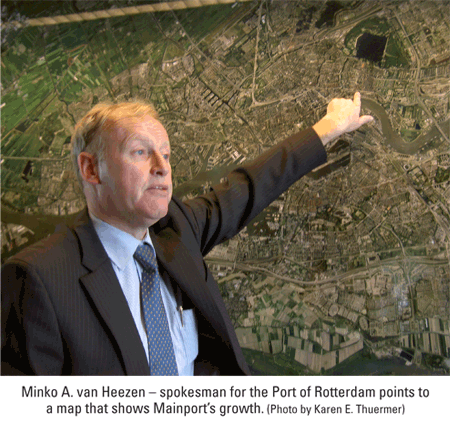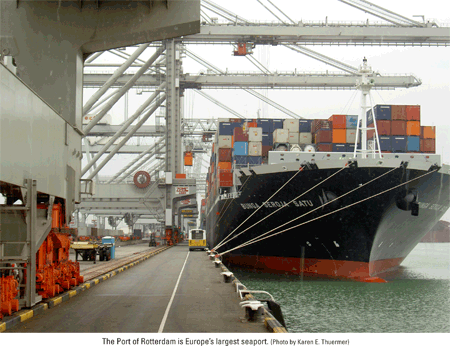By Karen E. Thuermer, AJOTThe Port of Rotterdam (Mainport) excels above all other European ports in terms of throughput. In 2005, the port handled 370.2 million tons, 171.3 million tons of which was liquid bulk cargo; 91.2 million tons of containerized freight, and 89.4 million tons of dry bulk cargo. Antwerp, Europe’s second busiest port, handles less than half of Rotterdam’s totals. In 2005, Rotterdam was the third busiest port worldwide behind No. 1 Shanghai, and No. 2 Singapore.

Mainport is mammoth. Covering 25,935 acres comprised of 12,350 acres of industrial sites; 8,645 acres of waterways, and 4,940 acres of rail, road, pipelines and greenery. Mainport also encompasses three large-scale distripark areas: Maasvlakte, Botlek, and Eemhaven. Maasvlakte is the largest, located right on the North Sea next to the ECT Delta Terminal. Each distripark is strategically located close to major container terminals and the city’s transport links to the European market.
With containerized capacity expected to increase over 40%, from 9.3 million teus in 2006 to 16 million teus in 2013, Mainport is experiencing major efforts to expand capacity capabilities in anticipation of this huge growth. The goal is to retain its position as Europe’s primary seaport.
DistributionDistribution is a major focus for the port. “Not every type of distribution should be here,” comments Minco A. van Meezen, port spokesman. “We are focusing on larger volume distribution in and out.”
Nippon Express/Cannon, DHL/Epson, Reebok, Excel and a host of others are already located at the port. “They do a limited amount of value added logistics, such as receiving, repacking, and light manufacturing, but it is not prevalent,” van Meezen says. “We are not under pressure to create jobs as some other ports are.”

Reaching out from the city to reclaimed land in the North Sea, the length of the port area is slightly over 30 miles. Some 35,000 deep sea ships and 130,000 inland waterway vessels call at the port each year.
ECT TerminalsEurope Container Terminals (ECT), which is part of the Hutchinson Port Holdings Group, operates three terminals at Rotterdam: ECT Delta Terminal, ECT Home Terminal, and ECT Hanno Terminal. The 583-acre ECT Delta Terminal offers water depth of nearly 56 feet, making it possible for 10,000-teu vessels to berth.
The ECT Delta Terminal is currently undergoing a major expansion. By the end of 2006, 27 deep sea cranes and one barge crane will be operational at the Delta Dedicated West Terminal (DDW) and Delta Dedicated East Terminal (DDE), increasing their capacity by 1.5 million container moves a year.
Other measures aimed at improving performance are also being implemented, such as terminal software, dual cycling (both loading and discharging a container in one single crane movement), twin carrying (two 20-foot containers on one AGV) and twin lifting (loading or discharging two 20-foot containers at the same time).
Betuwe RouteA distinguishing factor is that Rotterdam Mainport is a barge port. “This gives us a competitive edge,” says Alice H. Krecht, port marketing manager North America. “We offer good connections to the Rhine River.”
Today, 48% of the port’s business is destined for Europe’s hinterland. Only five percent, however, is transported by rail, a segment the port is working to upgrade. Twenty-one percent travels by pipeline, and 26% is transported by road. By comparison, 69% of inland freight in Germany moves by rail; 13% by barge, and 15% by rail.

Key to Rotterdam’s objectives for 2006-2010 is the development of the Betuwe Route, a dedicated freight-only line from Rotterdam to





